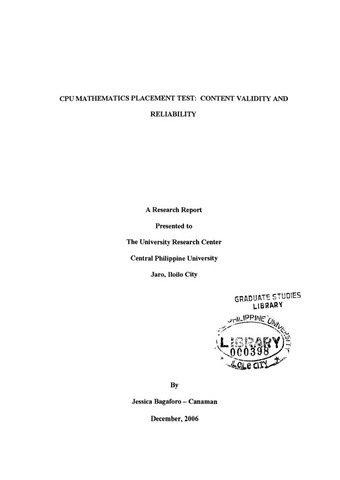CPU mathematics placement test: Content validity and reliability
| dc.contributor.author | Canaman, Jessica B. | |
| dc.date.accessioned | 2021-05-28T01:39:51Z | |
| dc.date.available | 2021-05-28T01:39:51Z | |
| dc.date.issued | 2006-12 | |
| dc.identifier.citation | Canaman, J. B. (2006). CPU mathematics placement test: Content validity and reliability (Research report). Jaro, Iloilo City: University Research Center, Central Philippine University. | en_US |
| dc.identifier.uri | https://hdl.handle.net/20.500.12852/912 | |
| dc.description | Abstract only | en_US |
| dc.description.abstract | This study determined the validity and reliability of the CPU Mathematics Placement Test. Moreover, it investigated the mathematical readiness of high school graduates for college mathematics and identified the basic mathematical strengths and weaknesses of the respondents as well as the mathematics areas in which they performed poorly and the areas they fared well. A population of 4,512 incoming first year college students who took the placement test administered during the six testing dates prior to the school year 2002 -2003 served as the study sample. Results of this study showed that the placement test is valid but not highly reliable. There exists a positive and significant but substantial correlation between placement test scores and grades in college algebra. Twenty eight percent of the variation in students’ performance in College Algebra may be attributed to or predicted by their scores in the Mathematics Placement Test. High school graduates are not adequately equipped with mathematical knowledge and skills necessary for college mathematics. They are deficient in all basic areas of mathematics namely arithmetic, algebra, geometry, trigonometry, statistics, and probability. While they could perform well in mathematical tasks which involve simple recall or straightforward manipulation, they could hardly achieve in tasks which require analysis and multi-step processes. In arithmetic, high school graduates demonstrated poor understanding of basic mathematical concepts and lack skills to perform arithmetic operations. In algebra, they lack competence in finding special products, factoring expressions, solving simple interest problem, finding percentage, classifying algebraic expression, dividing polynomials, finding solution set or roots of linear and quadratic equations, performing series of operations, simplifying complex fraction, and even identifying term of radical expression. In geometry, they demonstrated lack of conceptual understanding of basic terms and skills necessary to solve geometry related problems. In trigonometry, high school students failed to exhibit understanding of concepts related to the properties of a line. In statistics and probability, the respondents showed lack of skills in calculating mean, finding probability of event, reading and interpreting graphs, and solving permutation problem. | en_US |
| dc.format.extent | viii, 66 leaves | en_US |
| dc.language.iso | en | en_US |
| dc.publisher | Central Philippine University | en_US |
| dc.subject.ddc | GSL 510.72 C16 | en_US |
| dc.subject.lcsh | Mathematics--Examinations | en_US |
| dc.subject.lcsh | Central Philippine University | en_US |
| dc.subject.lcsh | Universities and colleges--Entrance examinations | en_US |
| dc.subject.lcsh | Central Philippine University--Entrance examinations | en_US |
| dc.subject.lcsh | Reliability | en_US |
| dc.subject.lcsh | Examinations--Validity | en_US |
| dc.title | CPU mathematics placement test: Content validity and reliability | en_US |
| dc.title.alternative | Central Philippine University mathematics placement test: Content validity and reliability | en_US |
| dc.type | Technical Report | en_US |
| dcterms.accessRights | Limited public access | en_US |
| dc.description.bibliographicalreferences | Includes bibliographical references | en_US |
이 항목의 파일
This item appears in the following Collection(s)
-
Research reports [42]
-
Research reports [167]


